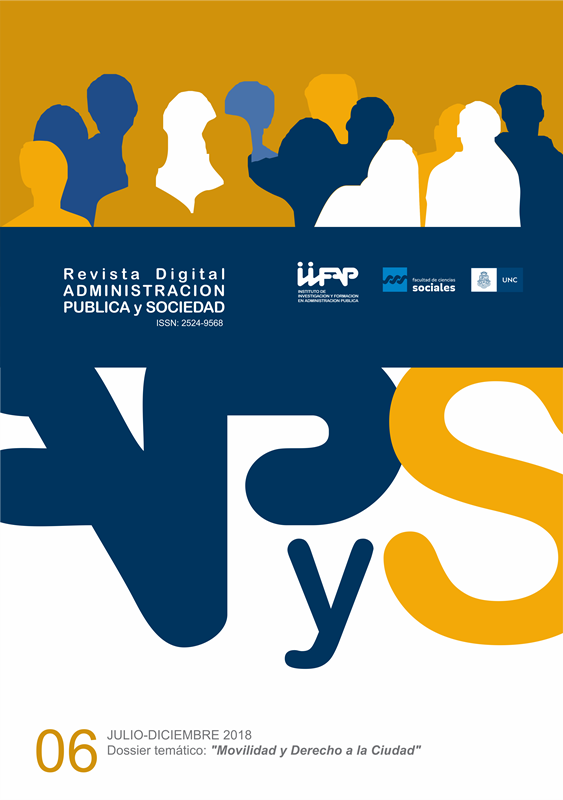Sustainable urban mobility: some basic principles and solutions
Main Article Content
Abstract
Article Details
Section
Authors who publish in this journal accept the following terms of the copyright policy:
- Authors shall retain their copyright (including copyrights) and shall grant to the journal the right of first publication of their work, which shall simultaneously be subject to the Creative Commons Recognition License: No commercial use of the original work or any derivative works is permitted, distribution of which must be made under a license equal to that which governs the original work.
- Authors may adopt other non-exclusive license agreements for the distribution of the version of the published work (e.g., placing it in an institutional repository or publishing it in a book) provided that the initial publication in this journal is indicated.
- Authors are allowed and encouraged to disseminate their work through the Internet (e.g., in institutional repositories or on their website) after the publication process, which may lead to interesting exchanges and increased citations of the published work. (See The Effect of Open Access).
How to Cite
References
Ampt, E.S. y Ortúzar, J. de D. (2004) On best practice in continuous large-scale mobility surveys. Transport Reviews 24, 337-363.
Basso, L.J., Silva, H.E. y Riquelme, I. (2017) Urban road congestion management: capacity investments and pricing policies. 13th International Conference of The Western Economic Association International, 3-6 Junio, Pontificia Universidad Católica de Chile, Santiago.
Burford, G., Hoover, E., Velasco, I., Janoušková, S., Jimenez, A., Piggot, G., Podger, D. y Harder, M.K. (2013) Bringing the “missing pillar” into sustainable development goals: towards intersubjective values-based indicators sustainability. Sustainability 5, 3035-3059.
Braess, D., Nagurney, A. y Wakolbinger, T. (2005) On a paradox of traffic planning. Transportation Science 39, 446–450.
Campoli, J. (2012) Made for Walking: Density and Neighbourhood Form. Lincoln Institute of Land Policy, Washington, D.C.
Cantillo, V. y Ortúzar, J. de D. (2014) Restricting the use of cars by license plate numbers: a misguided urban transport policy. Dyna 81, 75-82.
CEDEUS (2017) Centro de Desarrollo Urbano Sustentable (www.cedeus.cl), Santiago.
CEDEUS-MINVU (2018) Sustentabilidad a Escala de Barrio. Re-visitando el programa “Quiero mi Barrio”. Ministerio de Vivienda y Urbanismo, Santiago.
Cervero, R. y Kockelman, K. (1997) Travel demand and the 3Ds: density, diversity and design. Transportation Research Part D: Transport and Environment 2, 199-219.
De Lisio, A. (1999) Desarrollo sustentable: opciones y limitaciones para América Latina y el Caribe. Revista Cuadernos del Cendes 16, 1-23.
Downs, A. (1962) The law of peak-hour expressway congestion. Traffic Quarterly 16, 393–409.
Harding. T. (2014) Common Sense Fallacy.(https://yandoo.wordpress.com/2014/12/28/common-sense-fallacy/).
Hensher, D.A. y Bliemer, M. (2014) What type of road pricing scheme might appeal to politicians? Viewpoints on the challenge in gaining the citizen and public servant vote by staging reform. Transportation Research Part A: Policy and Practice 61, 227-237.
Informe Brundtlandt (1987) Nuestro Futuro Común. Comisión Mundial para el Medio Ambiente y el Desarrollo, ONU, Washington, D.C.
International Union for Conservation of Nature and Natural Resources (1980) World Conservation Strategy: Living Resource Conservation for Sustainable Development. ONU, Gland, Suiza.
Jacobs, J. (1961) The Death and Life of Great American Cities. Random House, Nueva York.
Kimber, R.M, McDonald, M. y Hounsell, N. (1985) Passenger car units in saturation flows: concept, definition, derivation. Transportation Research Part B: Methodological 19, 39-61.
Littig, B. y Griessler, E. (2005) Social sustainability: a catchword between political pragmatism and social theory. International Journal of Sustainable Development 8, 65-79.
Miller, E. (2018) Viewpoint: integrated urban modelling- past, present and future. The Journal of Transport and Land Use 11, 387-399.
Mogridge, M.J.H. (1990) Planning for optimum urban efficiency: the relationship between congestion on the roads and public transport. Transportation Planning Systems 11–19.
Mogridge, M.J.H., Holden, D.J., Bird, J. y Terzis, G.C. (1987) The Downs-Thomson paradox and the transportation planning process. International Journal of Transport Economics 14, 283-311.
Ortúzar, J. de D., Bascuñán, R., Salata, A. y Rizzi, L.I (2018) Assessing the potential acceptability of road pricing in Santiago. Transportation Research Part A: Policy and Practice (en revision).
Ortúzar, J. de D. y Willumsen, L.G. (2011) Modelling Transport. John Wiley and Sons, Chichester.
Rittel, H.W.J y Webber, M.M. (1973) Dilemmas in a general theory of planning. Policy Sciences 4, 155-169.
Rizzi, L.I. y de la Maza, C. (2017) The external costs of private versus public road transport in the Metropolitan Area of Santiago, Chile. Transportation Research Part A: Policy and Practice 98, 123-140.
Schrank, D., Eisele, B., Lomax, T. y Bak, J. (2015) 2015 Urban Mobility Scorecard. The Texas A&M Transportation Institute, College Station, TX.
Smart Growth America (2015) Safer Streets, Stronger Economies: Complete Street Project Outcomes from Across the Country. Smart Growth America, Washington, D.C.
Spangenberg, J.H., Omann, I. y Hinterberger, F. (2002) Sustainable growth criteria. minimum benchmarks and scenarios for employment and the environment. Ecological Economics 42, 429- 443.
Thomson, J.M. (1977) Great Cities and Their Traffic. Gollancz, Peregrine Edition, Londres.
Wilson, P. (2015) Urban Sustainability Theory and Practice. Routledge, Londres.

